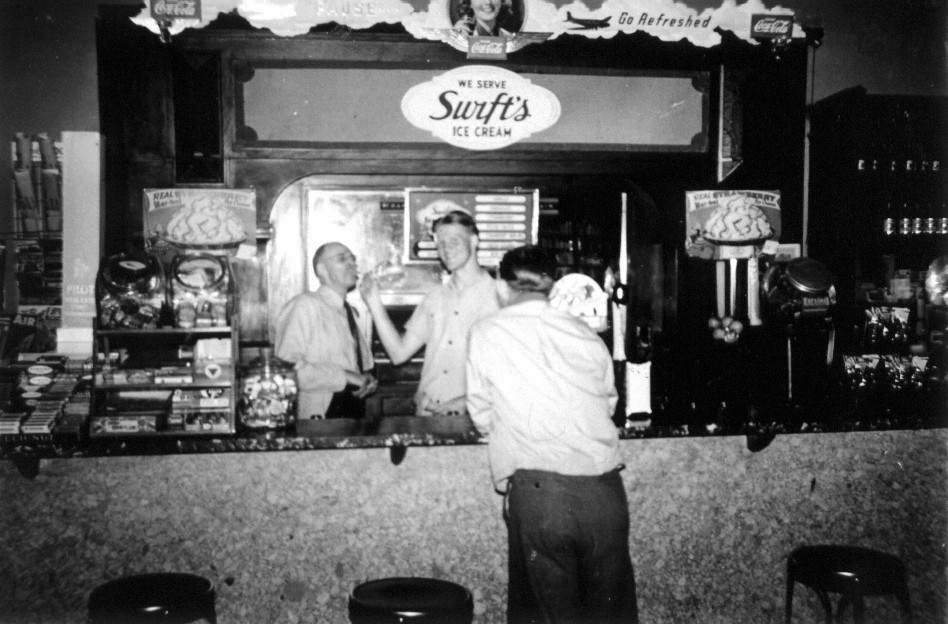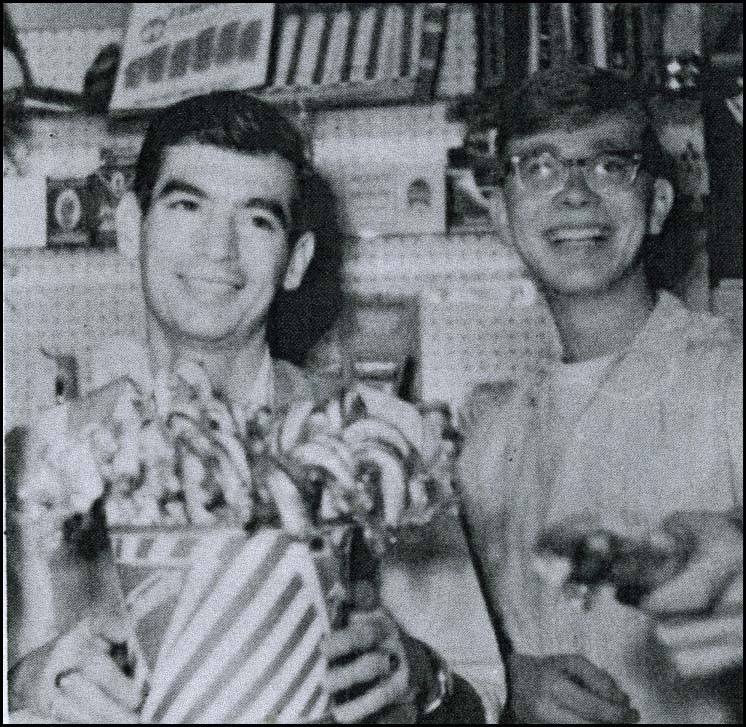Sweet Memories
By Katie Shands
Today, soda fountains are few and far between, but in the forties and fifties, they formed the backbone of America’s Main Streets. Franklin was no exception. Several soda fountains operated on its Main Street in those days, serving as social hubs for a town where “everyone knew everyone.” From the lawyers who worked on the square to young kids armed with allowance money, these places attracted a wide variety of customers. However, they were especially popular hangout spots for local teenagers.
As was common practice at that time, these soda fountains operated in conjunction with pharmacies. The reason for this dates back to the 1800s when druggists offered fountain drinks for various ailments. These beverages often contained extracts of flavored, effervesced drugs–cocaine and caffeine were a common combination. Fountain drinks became such crowd-pleasers that druggists began to install marble countertops and mirrored backdrops to create attractive places for customers to enjoy their concoctions.
When Prohibition shut down the bars in 1920, soda fountains filled the social void, and almost every drug store had its own version of one. But instead of opiates and stimulants, soda jerks whipped up chocolate malts and root-beer floats. Eventually, foods such as hamburgers and sandwiches were added to many menus.
So, fix yourself a milkshake, put on a record, and join us as we tour the soda fountains that once graced Franklin’s Main Street.
Corner Drug Store
In the summer of 1935, William “Doc” Jenkins came to Nashville with his wife, Hazel, to visit her father. At that time, the couple was living in Alamogordo, New Mexico, where Doc worked as the manager and pharmacist at Corner Drug Store.
As fate would have it, John C. North, the last surviving brother of the North Brothers Drug Store in Franklin, had recently passed away, and the firm was up for sale. Doc purchased the business during his Tennessee trip and soon moved to Franklin. Hazel, who was a teacher for the blind, remained in New Mexico to fulfill the remainder of her contract. At the conclusion of the school year, she joined her husband in Franklin.
Doc decided to reuse the name “Corner Drug Store” as it suited his new shop, which was situated in the corner building where Starbucks operates today. With its prime location on the busy intersection known as “Five Points” and across the street from what was then Franklin Elementary School, Corner Drug became a happening spot. The store boasted a pharmacy, a wide selection of magazines, various sundries, and, eventually, pinball machines, but it seems the soda fountain was the main attraction. Not only did it offer sweet treats made with top-notch ice cream, the menu also included a range of snacks and light meals.
Most locals agreed that Corner Drug had the best chocolate malts around. It’s even said that teen heartthrob Pat Boone would enjoy one whenever he was in town to sing at revivals hosted by the Fourth Avenue Church of Christ. More often than not, Pat would be wearing his signature white buck shoes on his visits to Corner Drug.
In the early sixties, Doc sold the shop and moved to Columbia, Tennessee, where he bought the Gray & Allen Drug Store. Dr. Armand “Jim” Heise purchased the Franklin business, which was re-branded to “Corner Rexall Drug.” He owned it until his death in 1982. After his passing, the store changed hands a couple times. In 1987, it was renamed “Five Points Drug Store.” After a remodel in 1995, the business became “Five Points Place 1923,” complete with a new dining area. Starbucks moved into the building five years later.



Gray Drug Company
After growing up on a farm, William “Frank” Gray, Sr. decided to forge a different path for himself. In the early 1900s, he landed a job at Moran Drug Company (the successor of Pope Drug Company) in Franklin. He worked as a clerk and soda jerk, but also did odd jobs around the shop, such as making fires, sweeping the floors and tidying up. To save money, Frank slept above the store in shared quarters with the owner John Moran.
In 1913, Frank and his wife, Mary, moved to Hillsboro–today known as Leiper’s Fork–where he worked as the town’s druggist and postmaster. After five years, Frank was rehired at Moran Drug. In 1926, the business moved into a circa-1876 building that John Moran had purchased for $8,250. This is where the restaurant GRAY’S on Main now operates.
Frank became the drug store’s manager in 1931 after John Moran retired. Two years later, Frank and pharmacist Cannon Kinnard established the Kinnard-Gray Drug Company in the former location of Moran Drug. After Kinnard died in 1938, the business became “Gray Drug Company.” Frank
later partnered with pharmacist William Miller in 1946.
Gray Drug’s soda fountain was arguably the most popular in town, and business hit its peak on Saturdays when farmers and their families came to town to do their shopping. The counter, which stretched along the left wall, bustled with customers hungry for milkshakes, malts and burgers. Marble-topped tables in the middle of the store offered additional seating for those who preferred a chair over a stool.
The store was also especially busy during the months before school started. In the 1900s, John Moran had been a state agent for school supplies and was the sole merchant in Franklin carrying this line. Gray Drug must have inherited this contract because it was the only place in town that sold the required school workbooks. The shop also offered dictionaries, tablets, pencils and book satchels.
In the mid-fifties, Frank installed the iconic neon sign that remains a centerpiece of Main Street. His wife protested, saying it was entirely too large, but to his credit, he didn’t listen. Around this same time, Frank and William added Ralph Duke, Sr. to their team. Bill Garrett was a later associate.
In 1962, an era came to an end: The soda fountain was removed and replaced by a soft-drink machine, ice-cream freezer, candy counter and Mr. Peanut dispenser. Another major change came to the company in 1967 when Frank died. He was Franklin’s oldest active businessman at the time of his passing.
In 1996, Gray Drug sold its pharmacy to Revco and became “Gray’s Card and Gift” until closing in 2004. A second location had opened on Carter’s Creek Pike, which also shut down at this time. The Main Street building sat empty for years until Michael and Joni Cole bought it and opened GRAY’S on Main in 2013.

Sandlin Drug Company
In 1899, White Drug Company moved into a newly constructed building at 404 Main Street (now The Heirloom Shop). Confederate veteran Dr. John B. White operated the firm, and his name remains etched into the facade near the roofline. Based on newspaper articles from that time, it seems he was business partners with his brother, Dr. William White. Interestingly, John’s son, Dr. Samuel White, erected the building where Corner Drug was later located.
After John’s death in 1910, his son-in-law James A. Henderson took the helm at White Drug. It’s unknown when the soda fountain was first installed, but it was definitely there during James’s tenure. The earliest known mention of the soda fountain is in a 1915 advertisement.
When James retired in 1950, George P. Gill of Brownsville, Tennessee bought the business. Though White Drug Company was a Main Street institution (founded in 1877, it was the oldest retail firm in Franklin at that point), George renamed it “Gill Drug Company.”
That same year, Floyd and Lucinda Sandlin moved to Franklin from Gallatin, Tennessee. Floyd was hired as
a pharmacist at Gray Drug Company, but when Gill Drug went up for sale, he decided it was time to strike out on his own. He bought the business in 1954 and changed it to “Sandlin Drug Company.” The name soon became synonymous with friendly service, delicious food and good times.
Many former customers recall walking into Sandlin Drug and being greeted by the smell of warm, mixed nuts from a machine near the door. Beyond the entrance, the store was filled with a variety of products: magazines, comic books, greeting cards, cigars, cigarettes, cosmetics, toys and candy. The pharmacy was situated in the back of the shop, and the soda fountain hugged the left wall. It featured a black-and-white-striped canopy, which was later recovered in wooden shingles. Customers sat on stools in front of the counter and enjoyed such menu items as sundaes, pimento-cheese sandwiches and cherry Cokes made with real syrup.
Men liked to congregate at the nearby tables and chairs, drinking coffee and “solving the world’s problems,” as one local put it. When the soda fountain was removed in a later remodel, the men moved next door to a room above what was then the Harpeth National Bank.
After Floyd died in 1963, his wife, Lucinda, operated the store with partners Bill Cook and Joe Jones. In 1972, Lloyd Shouse purchased Lucinda’s remaining interest. The Main Street location closed in 1979, but there were two other Sandlin Drug stores on Carter’s Creek Pike that remained open. Lucinda continued to work with the company until it was sold in 1995.

The Decline of the Soda Fountain
By the 1970s, the soda fountain was largely a thing of the past in America. Fast food, commercial ice cream and vending machines all contributed to its decline. Today, there are no soda fountains on Franklin’s Main Street, but these places are remembered with great fondness by those who spent time there. Perhaps one day, Main Street will gain another soda fountain, and a new generation can enjoy the simple pleasure of sipping a hand-mixed milkshake on a counter-height stool.





















